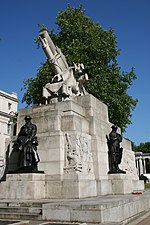Apsley House

Apsley House is the London townhouse of the Dukes of Wellington. It stands alone at Hyde Park Corner, on the south-east corner of Hyde Park, facing south towards the busy traffic roundabout in the centre of which stands the Wellington Arch. It is a Grade I listed building. Designed by Robert Adam in the neoclassical style, the house was built for Lord Aplsey in the 1770s. It came into the hands of the 1st Duke of Wellington in 1817, and was sometimes referred to as Number One, London. It is perhaps the only preserved example of an English aristocratic townhouse from its period. The house is also called the Wellington Museum, its official designation under a 1947 Act of Parliament. It is now run by English Heritage and is open to the public as a museum and art gallery, exhibiting the Wellington Collection, a large collection of paintings, other artworks and memorabilia of the career of the 1st Duke. The 9th Duke of Wellington retains the use of part of the buildings. The practice has been to maintain the rooms as far as possible in the original style and decor of the 1st Duke.
Excerpt from the Wikipedia article Apsley House (License: CC BY-SA 3.0, Authors, Images).Apsley House
Piccadilly, London Belgravia
Geographical coordinates (GPS) Address External links Nearby Places Show on map
Geographical coordinates (GPS)
| Latitude | Longitude |
|---|---|
| N 51.5035 ° | E -0.1517 ° |
Address
Apsley House (Number One, London)
Piccadilly 149
W1J 7NT London, Belgravia
England, United Kingdom
Open on Google Maps











